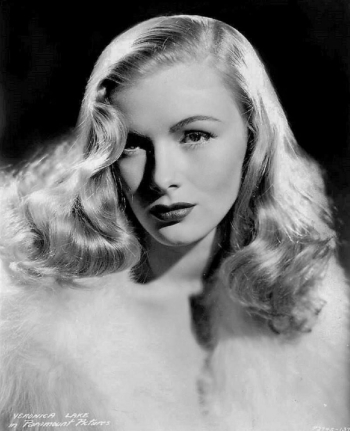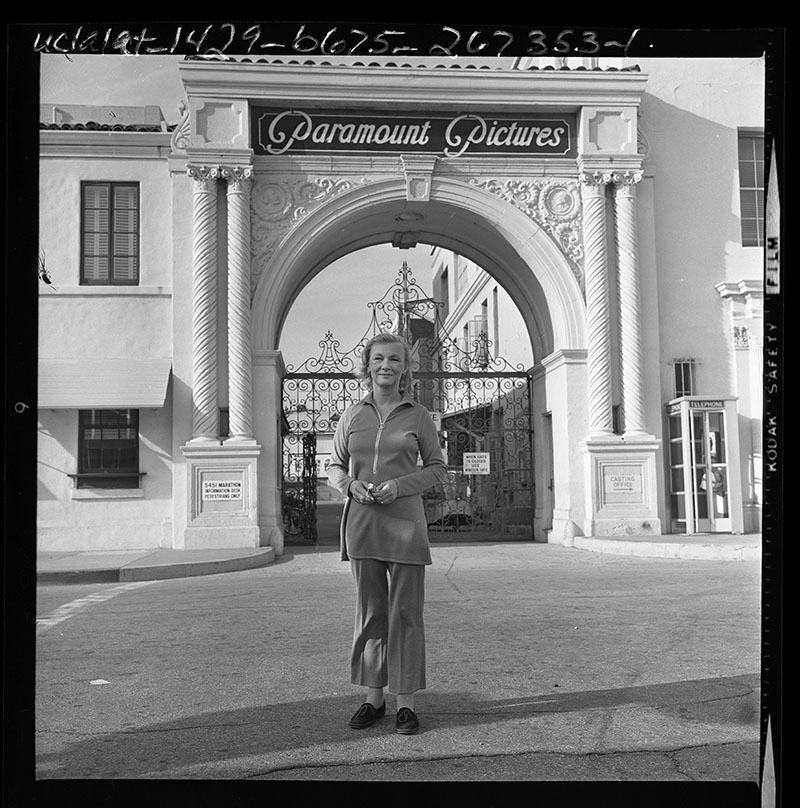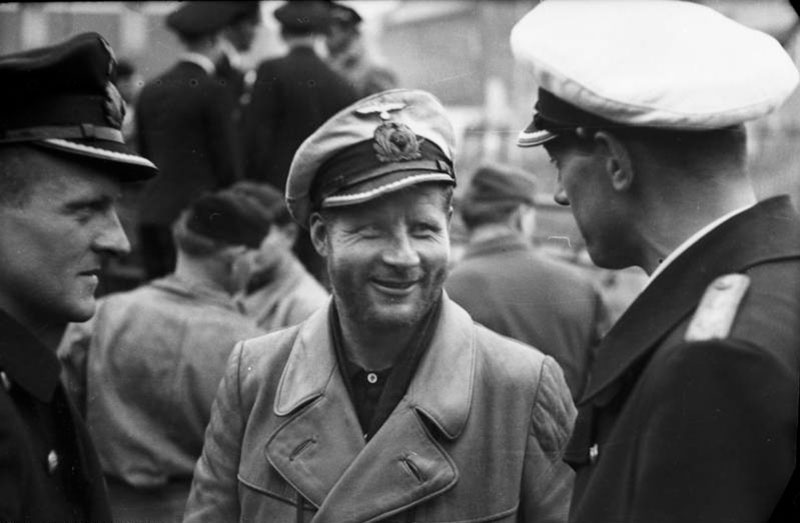Last Saturday I asked, "Without cheating, do you know, or can you guess, who these people are?" I mentioned that the Commentariat usually figures out identities, but I wondered if anyone would guess how I'll link them. William Cowan figured out one odd link—see the first Featured Comment.
We've done this kind of feature before—here's our very first Mystery Man, a picture of Abe Lincoln—the one on the left at the link, the "Kaplan Daguerreotype." The controversy over the authenticity of the picture has outlived Albert Kaplan, who died in 2022.)
Photo by Kathleen Ballard, courtesy of The Regents of the University of California
This is Veronica Lake, born Constance Frances Marie Ockelman, outside the gates of Paramount Pictures in Los Angeles, California, in 1971, two years before her death from alcoholism. She was a movie star and a WWII-era pinup beauty who lived a dysfunctional life and was notorious for being difficult to work with. She was famous well before my time—born 11 years before my mother—and I don't believe I've ever seen one of her movies. As one does with so much of culture, though, I know of her without knowing of her, because, in her case, of her signature look, long shining blonde hair falling fetchingly down over one eye. She made that so-called "peek-a-boo" hairstyle so popular during WWII that the Federal Government asked her to change it—too many young women, working in factories while the men were away, were copying it, and it wasn't suitable or safe for factory work. (One famous aficionado of the peek-a-boo hairstyle? None other than Jessica Rabbit.)
The best movie ever made about movies and Hollywood is of course Billy Wilder's Sunset Boulevard. It's one of those movies that rewards re-watching regularly even if a decade or two goes by between viewings. (It's good to read about it, too, in between.) It's all about illusion, image, and fantasy, about wanting fame and trying to hold on to it and losing it. Of course, it's also about the way Hollywood, and showbiz and fame in general, discards people after it's done with them. The movie has so many twists and turns, so many in-foldings, inside jokes, and cameos that it's almost impossible to pin them all down and be aware of everything that's going on all at once. Reality blends into fiction and back again—both in the plot, and for the actors. It's a film of hidden truths and exposed deception, a film of prisms and references and mirrors, like the mirror on the bottom of the swimming pool that Wilder and cinematographer John F. Seitz used to get the famous shot, from underneath, of the murdered Joe Gillis floating face-down. Gloria Swanson, who was once a silent movie star and makes a late-career triumph in this movie, plays silent film star Norma Desmond, who has been discarded because of her age and the transition to the talkies, and who wants to stage a "return" to the camera, the lights, and public attention—as she surely does at the end of the film, when she makes her dramatic entrance and descends the stairs for her "closeup"—undoubtedly one of the most iconic scenes in American movies. (And I always use the term "iconic" advisedly.) Her devoted butler, Max, who is revealed in the fictional world of the film to have been one of Norma's husbands, is played by Erich von Stroheim, an émigré director also discarded by Hollywood. In one remarkable and conceptually convoluted scene, Norma Desmond and Max are watching one of Norma's old films in the private screening room of Norma's decrepit mansion—and the film being shown is one of Gloria Swanson's that was directed by von Stroheim.
 Veronica Lake, publicity photo for I Wanted Wings, 1941
Veronica Lake, publicity photo for I Wanted Wings, 1941
Veronica Lake was not a major movie star, perhaps, but she was an early "celebrity" in the more modern sense. She died of cirrhosis of the liver from heavy drinking at the age of 50, coincidentally the age of the washed-up fictional Norma Desmond in Sunset Boulevard.
Here's the caption: Bild 183: Im besetzten Gebiet: (Frankreich) Ein U-Boot kehrt von erfolgreicher Feindfahrt zurück. Kapitänleutnant Lehmann Willenbrock meldet sein Boot von erfolgreicher Feindfahrt zurück. PK - Aufnahme: Kriegsberichter Schwich (Sch.) 7601-41 "Fr". "Fr.OKW" Mai 41
Translation: Picture 183: In occupied territory: (France) A submarine returns from a successful combat mission. Lieutenant Commander Lehmann Willenbrock reports his boat back from a successful combat mission. PK - Photo: War correspondent Schwich (Sch.) 7601-41 "Fr". "Fr.OKW" May 41
Also added is: "For documentary purposes the German Federal Archive often retained the original image captions, which may be erroneous, biased, obsolete or politically extreme." So there's the credit.
Lieutenant Commander Heinrich Lehmann-Willenbrock was the character played by Jürgen Prochnow in the 1981 movie Das Boot (The Boat), the captain of the submarine. There is at least one Nazi among the crew, and I believe Lehmann-Willenbrock, as the captain and commander, would have been a Nazi as well. He doesn't survive in the movie (sorry for the spoiler, but hey, you've had 43 years to see the movie already), but he survived the war in real life. Das Boot is available for free this month on YouTube, without ads on YouTube Premium and with them if you don't subscribe to that.
"U-boat" is "an anglicized version of the German word U-Boot, a shortening of Unterseeboot (under-sea boat), though the German term refers to any submarine" (Wikipedia). Das Boot the movie is based on the book by Lothar-Günther Buchheim, the journalist who was "embedded," in today's terms, with U-boat 96. His character features prominently in the movie, although the action is not shown completely from his point of view.
In my opinion it's another all-but unique movie that bears re-watching at regular intervals; I've seen it at least three times since it came out. It's filmed—amazingly well—mainly from the perspective of the U-boat crew, and completely from the German perspective—which, for English-speakers from countries aligned with the Allies in WWII, puts our sympathies in an all-but unique neutral balance: as you watch the movie you can only root for the men (boys, really—the average age of German U-boat crews was around 20) on the submarine, but this is counterbalanced by the fact that they were our enemies then and killing the crews of Allied ships. U-boats sank 175 warships and 2,825 merchant ships in WWII, and U-96 sank or crippled 32, under five commanders. And it wasn't pretty. The core scene in the movie shows the leaders of the crew on the bridge watching sailors jumping from a stricken ship they had torpedoed earlier—the captain outraged because he assumed the crew should have been rescued by then, and another sailor crying, which is a true-to-life detail. Then, going against every tradition of seagoing sailors in peacetime since time immemorial, as survivors swim frantically toward the surfaced U-boat, their only hope, it backs away.
And then there is the knowledge that almost none of these sailors would survive the war: like the lives of allied bomber crews flying missions into Germany from bases in England, depicted in the movie Twelve o' Clock High with Gregory Peck and the later television series, which is written 12 o'Clock High*, few German submariners survived the war. The duty itself was all but a death sentence. Luftwaffe fighter pilots also died at a very high rate, and were also widely hated and persecuted in post-war Germany, for failing to protect the population from the bombers, as detailed in the book A Higher Call about the Charlie Brown–Franz Stigler incident. (That book is a cracking good read, by the way, even for pacifists.)
Here's the key to the movie, which will make the experience bloom if you watch the film with it in mind: it's an anti-war film.
There are certain movies so rich and deep that they are worth re-watching at intervals, and also worth reading about. Sunset Bouelvard, which is in part about "discarded people" like Veronica Lake (who worked as a waitress late in life), and Das Boot are two of them.
I wish I knew of more. Industry analysts consider "older males" the weakest target demographic, because old men typically just don't go to the movies. So I have my own personal list, but my pool of candidates is limited to the relatively few movies I've seen in my life. I was a big moviegoer in my youth but, like many older males, don't watch many any more.
Mike
*Also depicted in Joseph Heller's famous book Catch-22.
Original contents copyright 2025 by Michael C. Johnston and/or the bylined author. All Rights Reserved. Links in this post may be to our affiliates; sales through affiliate links may benefit this site. As an Amazon Associate I earn from qualifying purchases. (To see all the comments, click on the "Comments" link below or on the title of this post.)
Featured Comments from:
WILLIAM DEAN COWAN: "It is always interesting to find the stories behind photographs. They all have one; it's just a matter of whether their is a possibility of finding it. Veronika Lake's father was lost in a 1932 explosion on board the tanker ship M.S. Bidwell. The same ship was torpedoed by the German submarine U-160 in 1942. The captain of the U-boat was Kptlt. Georg Lassen. Both Kptlt. Georg Lassen and Kptlt. Heinrich Lehmann-Willenbrock were recipients of the U-Boat war badge with Diamonds."
Anton Wilhelm Stolzing: "Erich von Stroheim, while a great director, always exceeded his budget considerably, which did not help his career."
David B.: "Norma Desmond, not 'Nora.' [Thanks, fixed now. I think I remembered "Nora" from the Carol Burnett Show skit spoofing the film, which was actually my first exposure to the movie. —MJ] Veronica Lake was the companion of Joel McCrea in Preston Sturges' wonderful 1941 Sullivan's Travels...well worth watching just for its own sake, but also as a commentary, comedy and satire on Hollywood—just like Sunset Boulevard, but a little more light-hearted. Joel McCrea plays a Hollywood director who wants to make 'O, Brother Where Art Thou'...but comes across a greater truth about movies at the end. Veronica Lake plays his un-named 'gamine' sidekick, 'The Girl'...though playing it mostly as a boy. One hour twenty-six minutes of utter black-and-white bliss!"





I believe the first photo is of Lana Turner visiting the studio long after her retirement from acting.
Posted by: Henry Rinne | Saturday, 15 February 2025 at 08:36 PM
The second photo is Heinrich Lehmann-Willenbrock, captain of the U-Boat which hosted Lothar-Günther Buchheim, the author of "Das Boot."
Posted by: Dillan | Saturday, 15 February 2025 at 11:20 PM
My hypothesis would be that the lady is a former (famous) child actor returning to the film studios for the first time in decades. But that is pure speculation.
The man is clearly a German WW II U-Boat captain. I have seen him before, but his name escapes me. I believe that he was the one with the most “kills”.
One potential link could be the movie Das Boot ?
Posted by: Soeren Engelbrecht | Sunday, 16 February 2025 at 03:36 AM
The top picture is Veronica Lake and the lower one is U-boat commander Heinrich Lehmann-Willenbrock, later played by Jürgen Prochnow in Das Boot. I can't work out the connection though.
Posted by: Chris Bertram | Sunday, 16 February 2025 at 05:02 AM
Top photo - Veronica Lake
Bottom - Heinrich Lehmann-Willenbrock
Look alikes?
Posted by: James Bullard | Sunday, 16 February 2025 at 11:11 AM
Stumped...but the second one is a U-Boot captain. Checked it on the interwebby, and it's Heinrich Lehmann-Willenbrock. A rare one in that he survived the war---the U-Boot service had the worst survival record of all the Nazi services.
Posted by: Tex Andrews | Sunday, 16 February 2025 at 11:47 AM
If you want a bit of Hollywood fluff starring Veronica Lake, try "I Married A Witch" with Fredrick March. It's the kind of picture that rises to the top of Amazon Prime during the annual Halloween run-up. Goofy practical effects. But you'll get what folks liked about Lake. She definitely had something the camera loved, and audiences along with it.
Posted by: Benjamin Marks | Sunday, 16 February 2025 at 01:25 PM
Burgess Meredith?
Posted by: Graeme Scott | Sunday, 16 February 2025 at 04:19 PM
Is the chap in the photo wearing naval attire the German WW II U-boat captain, Gunther Prien? Prien sank 32 allied ships before he disappeared at sea with his crew and U-boat.
Posted by: omar n fernandez (aka Tippler) | Sunday, 16 February 2025 at 04:55 PM
Re WWII allied bomber crews, see also the recent Apple TV drama series and companion documentary about the "jinxed" 100th bomber group, based on a book by Donald L. Miller. The series is Masters of the Air and the documentary is The Bloody Hundredth. Not a series I'm likely to rewatch, despite its impressive recreations of bombers, bases and air combat. Its dramatic potential was somewhat undermined by a sentimental halo, in contrast to, say, the grittier Das Boot. But perhaps that's something of a mercy. The most sobering thing about the 100th's story (or rather, storIES, many of which ended there) is that its losses were statistically average for the theater's bomber groups. It earned its reputation because those losses were concentrated in two particularly tragic missions.
A writeup at the national WWII museum: https://www.nationalww2museum.org/war/articles/bloody-100th-bomb-group
Posted by: robert e | Monday, 17 February 2025 at 11:22 AM
In the movie L.A. Confidential, which is set in the early 50’s, there is a group of prostitutes who have been styled and in some cases, surgically altered, to resemble popular Movie Stars of the time. Kim Basinger’s character, Lynn Bracken, is the Veronica Lake of the group. The similarity of her character with the real actress is uncanny.
Posted by: Dave Richardson | Monday, 17 February 2025 at 01:25 PM
In the spirit of this discussion, The Burmese Harp just aired on TCM. Highly recommended.
Posted by: Mike Plews | Monday, 17 February 2025 at 03:17 PM
"Max . . . is played by Erich von Stroheim, an émigré director also discarded by Hollywood."
Going by the wikipedia entry for von Stroheim, it was more his disregard of film budgets that got him "released" as the director for several films. If true, it's a little different than "being discarded". (However, I don't know what sources you used.)
(During the making of Greed, in 1924, the production company (Goldwyn Pictures) merged into MGM. From wikipedia: "Originally almost eight hours long, Greed was edited against von Stroheim's wishes to about two-and-a-half hours. Only twelve people saw the full-length 42-reel version, now lost; some of them called it the greatest film ever made.")
Anyhow, Sunset Boulevard is one of the better movies I've ever seen. I watched it the first time on (maybe) TCM (Turner Classic Movies). Once you start watching, you'll likely have to watch it to the end.
I almost wanted to shout at the Joe Gillis character to get away from "Nora Desmond". You could tell that he was in deeper trouble than he knew.
The movie may have been released when color film was available, but this film, in my opinion, had to be in black and white. The old mansion wouldn't have had the same effect in color. All the dim corners of the rooms that made me look closely to see if something or someone were there.
I recognized Cecil B. DeMille and Buster Keaton, but I didn't recognize Hedda Hopper or Jay Livingston, or . . . (before my time)
The ending is surreal, but so appropriate.
Posted by: Dave | Monday, 17 February 2025 at 03:21 PM
Even better than the movie of "Das Boot" is the original TV series -- it kept me glued to my 8" portable when it was broadcast by the BBC (?) in the mid 1980s. White-knuckle stuff! The movie is basically a digest of the TV series.
"Heimat" was broadcast around the same time, also a real treat for those of us with a bit of German and an interest in an alternative p-o-v to most English language war films and TV, and a "how we got here" take on modern Germany.
Mike
Posted by: Mike Chisholm | Monday, 17 February 2025 at 03:39 PM
The best version of Norma Desmond in Sunset Boulevard was Carol Burnett in her
TV show takeoff of Sunset Boulevard.
Posted by: Herman Krieger | Monday, 17 February 2025 at 05:30 PM
I saw Das Boot with an uncle of mine when it was in theaters. He served in a US submarine in WW2 in the Pacific theater and survived being depth charged. I still remember during an intense scene looking over and seeing sweat pouring down his face. After the movie he told me that was the best depiction of the pure hell and feeling of helplessness while being depth charged.
Posted by: James C Chinn | Tuesday, 18 February 2025 at 09:14 AM
Agree, Das Boot is one of the great anti-war films.
I was a young lad in DC when it came out, about the same time the District started clamping heavy metal contraptions to the rear wheels of traffic ticket heavy offenders' vehicles. We called those clamps "Das boots" and the District traffic cops "gutter Gestapo". ;-)
I recently discovered the 1985 Soviet anti-war film Come and See, about WWII Belarus. It is powerful and highly recommended!
Posted by: Andrew Bearman | Wednesday, 19 February 2025 at 03:00 PM